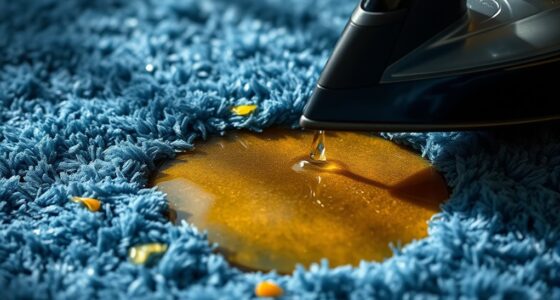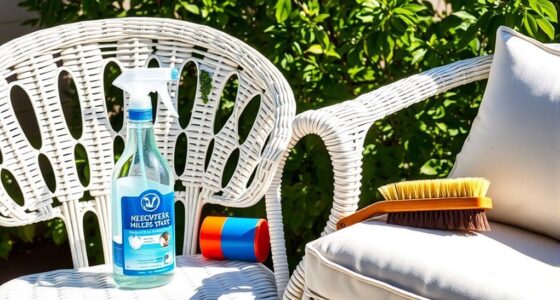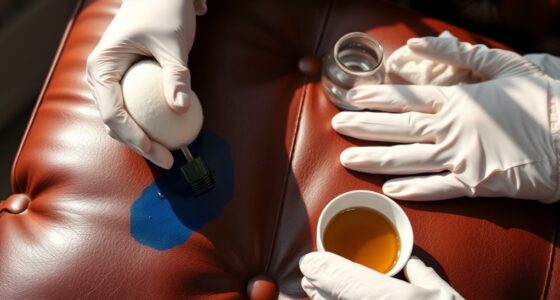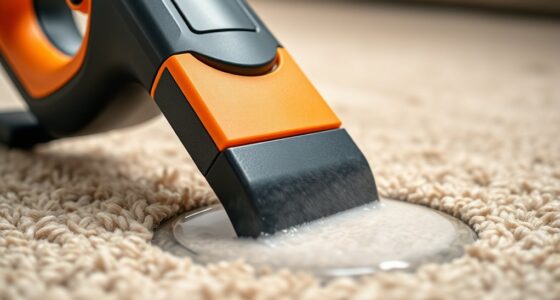To remove chewing gum with ice and a dull knife, start by wrapping ice cubes in a plastic bag or paper towel and pressing them against the gum for several minutes to harden it. Once it’s brittle, gently slide a dull knife or plastic scraper under the edges to lift the gum without scratching the surface. For best results, re-freeze if needed and finish by cleaning the residue with a damp cloth. Continue exploring for more tips on making this process even easier.
Key Takeaways
- Wrap ice cubes in a plastic bag or paper towel and hold against the gum to harden it.
- Gently slide a dull knife or plastic scraper under the hardened gum edges.
- Reapply ice if the gum becomes too soft or resistant during removal.
- Use a damp cloth or mild soap solution to clean any residue after removal.
- Protect the surface during removal to prevent scratching or damage.
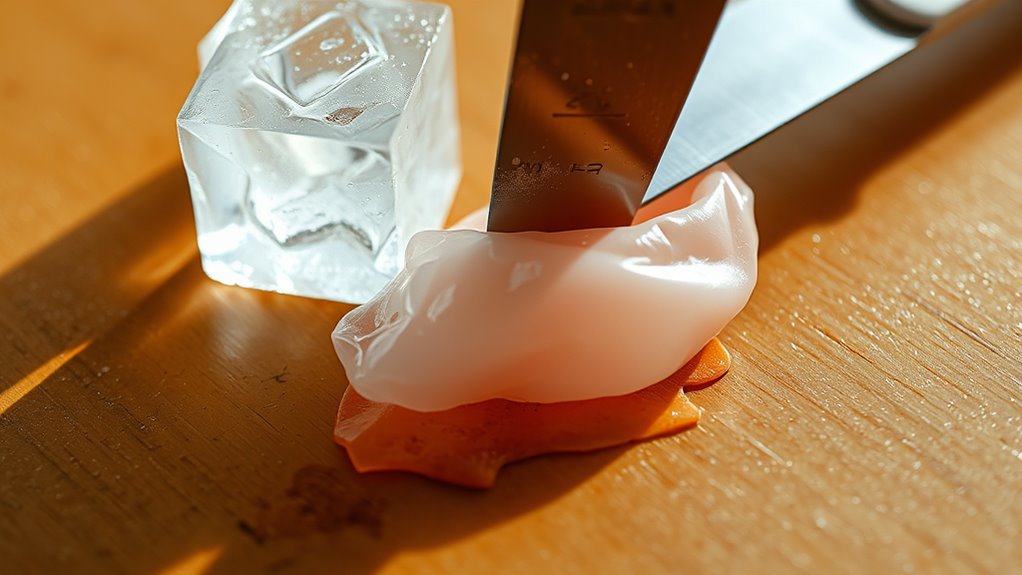
Removing chewing gum from surfaces can be a straightforward process if you know the right techniques. When tackling gum stuck on various surfaces, it’s important to contemplate both dental health and environmental impact. Chewing gum, if not disposed of properly, can contribute to pollution and pose risks to wildlife, making responsible removal essential. Using ice and a dull knife can be an effective, eco-friendly method that minimizes waste and avoids harsh chemicals.
Begin by gathering some ice cubes and a dull knife or a plastic scraper. The ice helps harden the gum, making it easier to remove without damaging the surface. You don’t need to buy specialty products; just use common household items. Wrap the ice cubes in a plastic bag or paper towel, then hold it against the gum for several minutes. The cold causes the gum’s sticky texture to harden, turning it brittle and less likely to smear or spread when you attempt to lift it.
Gather ice cubes in a plastic bag and hold against gum to harden it for easy removal.
Once the gum is sufficiently hardened, take your dull knife or plastic scraper. Gently slide it under the edges of the gum, applying light pressure. The goal is to lift the gum without scratching or gouging the surface beneath. If the gum is stubborn, reapply the ice to re-harden it, then try again. This process reduces the need for chemical solvents, which can have negative effects on both the environment and your dental health if used improperly or ingested accidentally.
As you lift the gum, aim to remove as much as possible in one piece. If residue remains, you can use a damp cloth or mild soap solution to wipe the area clean. Always rinse thoroughly afterward. Using this method also helps preserve the integrity of surfaces, preventing damage or deterioration over time. This simple method avoids harsh chemicals that can harm the environment, and it also prevents potential residues from affecting your dental health, especially if the surface is something you touch frequently or eat from.
This ice-and-dull-knife method is not only cost-effective but also environmentally friendly. It minimizes waste and reduces exposure to chemical cleaners that might contain toxins, which could indirectly impact your health. Plus, it’s gentle on surfaces, helping you preserve the integrity of your furniture or flooring without risking damage. By choosing this approach, you’re contributing to a cleaner environment and maintaining a healthier space around you, free from leftover gum and harmful chemicals. Overall, it’s a simple, effective way to remove chewing gum that aligns with your goals of protecting both your dental health and the planet.
Frequently Asked Questions
Can Ice Damage Delicate Surfaces When Removing Gum?
Yes, ice can cause cold surface damage if used improperly. When you apply ice directly to delicate surfaces, the extreme cold may cause cracking or warping, especially on materials like glass or thin plastics. To avoid ice damage, always wrap the ice in a cloth or towel and test on a small, inconspicuous area first. This way, you protect the surface from potential cold surface damage while removing gum effectively.
Is Using a Dull Knife Safe on All Types of Furniture?
Did you know that using a dull knife is safe on about 85% of furniture materials? Dull knife safety depends on furniture material compatibility—wood, laminate, or plastic usually handle it well. However, avoid using a dull knife on delicate surfaces like veneer or antique finishes, as it might cause scratches. Always test in a small inconspicuous area first to prevent damage and confirm safe, effective gum removal.
How Long Should I Apply Ice Before Attempting Removal?
You should apply ice for about 10-15 minutes to the chewing gum. The goal is to lower the temperature enough to harden the gum, making it easier to remove. Keep in mind that longer ice application can be effective, but avoid overdoing it to prevent damage to the surface. Check the gum periodically to see if it’s firm enough, and reapply ice if needed for better results.
Will the Ice Method Work on Sticky or Hardened Gum?
Think of ice as a magic wand for gum removal—its coldness can turn sticky, hardened gum into a brittle puzzle you can crack apart. Yes, ice effectiveness works on both sticky and hardened gum, making it easier to lift or scrape off. You just need to apply the ice long enough to freeze the gum solid. Once frozen, the gum becomes less clingy, helping you remove it with less effort and mess.
Are There Alternative Methods for Removing Gum if Ice Doesn’T Work?
If ice doesn’t work for chewing gum removal, you can try alternative techniques like applying peanut butter, which loosens the gum’s grip. Rubbing alcohol or vinegar can also help break down the sticky residue. For stubborn gum, consider using a plastic scraper or a toothbrush to gently lift it off. Remember, patience and gentle methods prevent damage to the surface while effectively removing the gum.
Conclusion
Now that you know how to remove chewing gum with ice and a dull knife, you can tackle sticky messes like a pro. It’s almost like freeing your favorite sweater from a stubborn knot—relieved and accomplished. Just remember to be gentle and patient, and soon your surface will be as good as new. With these simple tools and a steady hand, you’ll turn a sticky situation into a quick fix, leaving you happy and gum-free.


